|
|
|
|
|
|
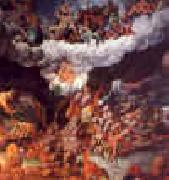 |
Giulio Romano
|
|
Italian
1492-1546
Giulio Romano was born in Rome. In his native city, as a young assistant in Raphael's studio, he worked on the frescos in the Vatican loggias to designs by Raphael and in Raphael's Stanze in the Vatican painted a group of figures in the Fire in the Borgo (L'incendio di Borgo) fresco. He also collaborated on the decoration of the ceiling of the Villa Farnesina. After the death of Raphael in 1520, he helped complete the Vatican frescoes of the life of Constantine as well as Raphael's Coronation of the Virgin and the Transfiguration in the Vatican. In Rome, Giulio decorated the Villa Madama for Cardinal Giuliano de' Medici, afterwards Clement VII. The crowded Giulio Romano frescoes lack the stately and serene simplicity of his master.
In the Palazzo Te, MantuaAfter the Sack of Rome in 1527 and the death of Leo X, artistic patronage in Rome slackened. Vasari tells how Baldassare Castiglione was delegated by Federico Gonzaga to procure Giulio to execute paintings and architectural and engineering projects for the duchy of Mantua. His masterpiece of architecture and fresco painting in that city is the suburban Palazzo Te, with its famous illusionistic frescos (c. 1525?C1535). He also helped rebuild the ducal palace in Mantua, reconstructed the cathedral, and designed the nearby Church of San Benedetto. Sections of Mantua that had been flood-prone were refurbished under Giulio's direction, and the duke's patronage and friendship never faltered: Giulio's annual income amounted to more than 1000 ducats. His studio became a popular school of art. |
|
|
|
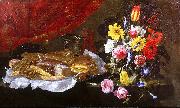 |
Giuseppe Recco
|
|
(1634 - 29 May 1695) was a still life Italian painter.
Born in Naples, he likely apprenticed with his family, including his father Giacomo Recco and uncle Giovan Battista Recco. His children both son Nicolo and daughter Elena were also painters. A large part of his output was painted in Spain, where his assemblies of victuals, both vegetable and animal, were popular. It is claimed he was influenced by the neapolitan Giovanni Battista Ruoppolo.
Recco died at Alicante, Spain. |
|
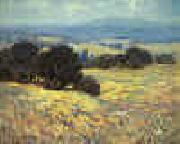 |
Granville Redmond
|
|
1871-1935
Granville attended the Berkeley School for the Deaf (later the California School for the Deaf) from 1879 to 1890 where his artistic talents were recognized and encouraged. There his teacher Theophilus d'Estrella taught him painting, drawing and pantomime.
When he graduated from CSD, Redmond enrolled at another CSD: the California School of Design in San Francisco, where he worked for three years with teachers such as Arthur Matthews and Amedee Joullion. He famously won the W. E. Brown Medal of Excellence. He associated with many other artists, including Gottardo Piazzoni and Giuseppe Cadenasso. Piazzoni learned American Sign Language and he and Redmond were lifelong friends. They lived together in Parkfield, California, and Tiburon.
1893 saw Redmond win a scholarship from California School of the Deaf and from the School of Design, which made it possible for him to study in Paris at the Academie Julian under teachers Jean-Paul Laurens and Benjamin Constant. At the Academie Julian, he roomed with sculptor Douglas Tilden, famous deaf sculptor and another graduate of the California School for the Deaf. In 1895 in Paris his painting Matin d'Hiver, was accepted for the Paris Salon. |
|
 |
Guido Reni
|
|
1575-1642
Italian
Guido Reni Galleries
Born in Bologna into a family of musicians, Guido Reni was the son of Daniele Reni and Ginevra de?? Pozzi. As a child of nine, he was apprenticed under the Bolognese studio of Denis Calvaert. Soon after, he was joined in that studio by Albani and Domenichino. He may also have trained with a painter by the name of Ferrantini. When Reni was about twenty years old, the three Calvaert pupils migrated to the rising rival studio, named Accademia degli Incamminati (Academy of the "newly embarked", or progressives), led by Lodovico Carracci. They went on to form the nucleus of a prolific and successful school of Bolognese painters who followed Annibale Carracci to Rome. Like many other Bolognese painters, Reni's painting was thematic and eclectic in style.
By late 1601, Reni and Albani had moved to Rome to work with the teams led by Annibale Carracci in fresco decoration of the Farnese Palace. During 1601-1604, his main patron was cardinal Sfondrato. By 1604-1605, he received an independent commission for an altarpiece of the Crucifixion of St. Peter. After a few year sojourn in Bologna, he returned to Rome to become one of the premier painters during the papacy of Paul V (Borghese). From 1607-1614, he was one of the painters patronized by Borghese.
Abduction of Deianira, 1620-1621.Reni's frescoed ceiling of the large central hall of garden palace, Casino dell'Aurora located in the grounds of the Palazzo Pallavicini-Rospigliosi, is considered his masterpiece. The casino was originally a pavilion commissioned by Cardinal Scipione Borghese; the rear portion overlooks the Piazza Montecavallo and Palazzo del Quirinale. The massive fresco is framed in quadri riportati and depicts Apollo in his Chariot preceded by Dawn (Aurora) bringing light to the world. The work is restrained in classicism, copying poses from Roman Sarcophagi, and showing far more simplicity and restraint than Carracci's riotous Triumph of Bacchus and Ariadne[5] in the Farnese. Reni in this painting is allies himself more with the sterner Cavaliere d'Arpino,Lanfranco, and Albani "School" of mytho-historic painting, and less with the more crowded frescoes characteristic of Pietro da Cortona. There is little concession to perspective, and the vibrantly colored style is antithetical to the tenebrism of Caravaggio's followers. Payments showed that he was paid in 247 scudi and 54 baiocchi upon completion on 24 September 1616.
He also frescoed in Paoline Chapel of Santa Maria Maggiore in Rome as well as the Aldobrandini wings of the Vatican. According to rumor, the pontifical chapel of Montecavallo (Chapel of the Annuciation) was assigned to Reni to paint. However, because he felt underpaid by the ministers, the artist left for Bologna, leaving the role of the preeminent artist in Rome to Domenichino. |
|
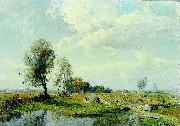 |
Gustaf Rydberg
|
|
painted Skansk slatt med pilvall - motiv fran Viby in 1923
Swedish, 1835-1933 |
|
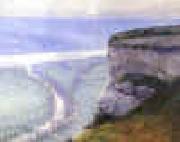 |
Guy Rose
|
|
1867-1925
Guy Rose Galleries
Guy Rose (3 March 1867?C17 November 1925) was an American Impressionist painter who is recognized as one of California's top impressionist painters of the late 19th and early 20th centuries.
Guy Orlando Rose was born March 3, 1867 in San Gabriel, California. He was the seventh child of Leonard John Rose and Amanda Jones Rose.
His father was a prominent California senator. He and his wife raised their large family on an expansive Southern California ranch and vineyard?? the San Gabriel Valley town of Rosemead bears the family name. In 1876 young Guy Rose was accidentally shot in the face during a hunting trip with his brothers. While recuperating he began to sketch and use watercolors and oil paints. He graduated from Los Angeles High School in 1884 and moved to San Francisco where he did his art training at the California School of Design.
In September 12, 1888, Rose enrolled at the Academie Julian in Paris and studied with Benjamin-Constant, Jules Lefebvre, Lucien Doucet and Jean-Paul Laurens while in Paris. In 1888-89, he won a scholarship at the Academie Delacluse. He met fellow students Frank Vincent and Frederick Melville at the Academie Julian -- Frank Vincent and Guy Rose were to remain lifelong friends.
Rose lived New York, New York in the 1890s and illustrated for "Harper's," "Scribners," and "Century". Choosing to return to France in 1899, he and his wife Ethel Rose bought a cottage at Giverny. In 1900 he resided in Paris and spent the winter in Briska, Algeria where he painted three known paintings. From 1904 to 1912 husband and wife lived in Giverny and his works from this period show the influence of "the master" Claude Monet, who became his friend and mentor.
In 1913-1914 the Roses summered in and held an outdoor sketching school at Narragansett, Rhode Island. Suffering on and off again from the effects of lead poisoning, Rose and his wife moved permanently to Los Angeles, California in 1914.
In Los Angeles, Guy Rose taught and served as Director of the Stickney Memorial School of Art in Pasadena. In 1921 he suffered a debilitating stroke that left him paralyzed. Guy Rose died in Pasadena, California on November 17, 1925. In 1926 the Stendahl Gallery held a memorial exhibition of his works. |
|
|
|
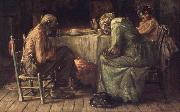 |
Harry Roseland
|
|
(c.1867-1950) was one of the most notable painters of the genre painting school around the turn of the 20th century. An American, Roseland was primarily known for paintings centered on poor African-Americans.
Roseland was largely self-taught, and never traveled to Europe to study art, as did many of the American artists of his time. However, he did receive instruction from John Bernard Whittaker and later, James Carroll Beckwith. One of his most popular subjects were his paintings of black women fortune tellers who read the palms and tea leaves of white women clients. These paintings were widely reproduced during the early 20th century in the form of postcard sets and large full-colour prints that were distributed as Sunday supplements in newspapers. While known most for his paintings of African Americans, his work encompassed many genres, including seascapes and portraits. He also gained renown for his paintings of laborers in the coastal areas of New England and New York and his many interior paintings.
Roseland was born and lived his entire life in Brooklyn. |
|
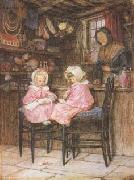 |
Helel Allingham,RWS
|
|
1848-1926
was a well-known watercolour painter and illustrator of the Victorian era. Helen Mary Elizabeth Paterson was born in Swadlincote in Derbyshire,[1] England. Her sister and her father, a doctor, died of diphtheria in 1862, and the rest of the family went to live in Birmingham. In 1867 she went to study art at the "Female School of Art", a section of what became the Royal College of Art in London, and became an illustrator of children's books. She was a great friend of Kate Greenaway. On 22 August 1874, she married William Allingham, who was almost twice her age. At the time, she was employed in illustrating some of the novels of Thomas Hardy, and they were attracted to one another when they met. Helen Allingham illustrated several books, including Six to sixteen: a story for girls (1876), Happy England (1903) and The homes of Tennyson (1905), written with her brother Arthur Paterson. After her marriage to Allingham, she became a watercolour painter, and she was the first woman to become a full member of the Royal Watercolour Society. |
|
|
|
Helen Allingham,R,W.S
|
|
1848-1926
Studies of Flowers
Studies of Flowers .was a well-known watercolour painter and illustrator of the Victorian era. Helen Mary Elizabeth Paterson was born in Swadlincote in Derbyshire,[1] England. Her sister and her father, a doctor, died of diphtheria in 1862, and the rest of the family went to live in Birmingham. In 1867 she went to study art at the "Female School of Art", a section of what became the Royal College of Art in London, and became an illustrator of children's books. She was a great friend of Kate Greenaway. On 22 August 1874, she married William Allingham, who was almost twice her age. At the time, she was employed in illustrating some of the novels of Thomas Hardy, and they were attracted to one another when they met. Helen Allingham illustrated several books, including Six to sixteen: a story for girls (1876), Happy England (1903) and The homes of Tennyson (1905), written with her brother Arthur Paterson. After her marriage to Allingham, she became a watercolour painter, and she was the first woman to become a full member of the Royal Watercolour Society. As well as landscapes, she completed several portraits, including one of Thomas Carlyle. |
|
|
|
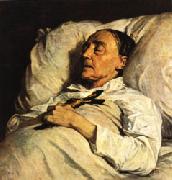 |
Henri Regnault
|
|
Paris 1843 - Buzenval 1871.
French Academic Painter, 1843-1871. Studied under Alexandre Cabanel. Specializes in Orientalism. Painter, son of Victor Regnault. He showed exceptional abilities as a draughtsman from an early age. After a traditional classical education he was sent in 1860 to the Ecole des Beaux-Arts, Paris, where he studied with Louis Lamothe (1822-69) and Alexandre Cabanel. In 1866 he won the Prix de Rome competition with Thetis Giving the Weapons of Vulcan to Achilles (Paris, Ecole N. Sup. B.-A.). In Italy he began several other ambitious history paintings, including Automedon Taming the Horses of Achilles |
|
|
|
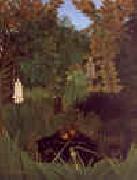 |
Henri Rousseau
|
|
French
1844-1910
Henri Rousseau Locations
He was born in Laval in the Loire Valley into the family of a plumber. He attended Laval High School as a day student and then as a boarder, after his father became a debtor and his parents had to leave the town upon the seizure of their house. He was mediocre in some subjects at the high school but won prizes for drawing and music. He worked for a lawyer and studied law, but "attempted a small perjury and sought refuge in the army," serving for four years, starting in 1863. With his father's death, Rousseau moved to Paris in 1868 to support his widowed mother as a government employee. In 1871, he was promoted to the toll collector's office in Paris as a tax collector. He started painting seriously in his early forties, and by age 49 he retired from his job to work on his art. His wife died in 1888 and he later remarried.
Rousseau claimed he had "no teacher other than nature", although he admitted he had received "some advice" from two established Academic painters, Felix Auguste-Clement and Jean-Leon Gerome. Essentially he was self-taught and is considered to be a naive or primitive painter. |
|
|
|
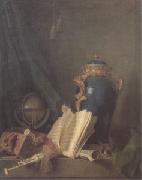 |
Henri-Horace Roland de La Porte
|
|
Paris 1724-1793
French painter. He was a pupil of Jean-Baptiste Oudry and was approved by the Academie Royale de Peinture et de Sculpture in 1761 as a 'painter of animals and fruit'. He presented his morceau de reception, the ambitious Vase of Lapis, Ornamented with Bronze and Placed near a Globe (Paris, Louvre), in 1763. This large painting is reminiscent of Oudry's work and depicts a collection of sumptuous objects against a simple cloth backdrop. Roland de la Porte's later works are much more intimate in scale and approach and depict simple rustic objects in a restrained yet realistic fashion in a manner akin to Chardin, for whose works his own have been mistaken. The Still-life with Bread and Fruit (Rotterdam, Boymans-van Beuningen) is bathed in a warm light; the composition is unusual in that the bread, plums and preserve pot are represented at the viewer's eye level, obscuring the top of the table. The Little Orange Tree (Karlsruhe, Staatl. Ksthalle) uses several devices similar to those used by Chardin: a light source comes from the upper left-hand side, throwing some of the surfaces into relief and highlighting them against the indistinct background; a single straw is brought into focus and seems to protrude out of the picture |
|
 |
Henrietta Rae
|
|
(30 December 1859 - 26 January 1928) was a prominent English painter of the later Victorian era.
Born in Hammersmith, London, she was the youngest of seven children of a civil servant; her mother was musically talented, a former student of Felix Mendelssohn. An uncle, Charles Rae, was an artist and a student of George Cruikshank. Rae began studying art at age thirteen; she was educated at the Queen Square School of Art, Heatherley's School of Art (she was its first female pupil), and the British Museum. She reportedly had to apply to the Royal Academy schools at least five times before she was accepted though she eventually gained a seven-year scholarship. Her teachers there included Frank Bernard Dicksee, William Powell Frith, and Sir Lawrence Alma-Tadema; the last of these had the strongest influence on Rae's later work. She became a frequent exhibitor at the annual Royal Academy shows, beginning in 1881.
She gained recognition and success early in her career, specializing in classical, allegorical, and literary subjects, often treated in a grand style and scale; her Psyche at the Throne of Venus (1894) measured 12 feet by 7 feet (305 by 193 cm) and contained 13 figures. Other paintings in the same classical vein include her Ariadne (1885), Eurydice (1886), Zephyrus and Flora (1888), Apollo and Daphne (1895), Diana and Calisto (1899), and Hylas and the Water Nymphs (1910) among many more. |
|
|
|
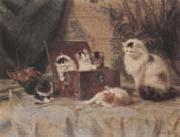 |
Henriette Ronner
|
|
French
1821-1909
He was a Dutch painter. Born Henriette Knip in Amsterdam, she moved at a young age to Den Bosch and was until 1850 active in Sint-Michielsgestel and Boxtel. That year she married Feico Ronner and moved to Belgium, first to Brussels and in 1878 to Elsene. She was best known for her paintings of subjects from nature, especially cats and dogs. |
|
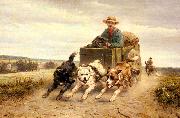 |
Henriette Ronner-Knip
|
|
was a Dutch painter.
Born Henriëtte Knip in Amsterdam, she moved at a young age to Den Bosch and was until 1850 active in Sint-Michielsgestel and Boxtel. That year she married Feico Ronner and moved to Belgium, first to Brussels and in 1878 to Elsene. She studied with her father, Joseph August Knip.
She was best known for her paintings of subjects from nature, especially cats and dogs.
|
|
|
|
|
|
|
|
 |
Henry Redmore
|
|
Henry Redmore was born in Hull in 1820. He lived his whole life in the North East of England, with his studio in Hull. Along with John Ward, Redmore was one of the best painters of the Hull School, although the two artists had distinctly different techniques |
|
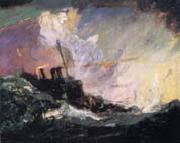 |
Henry Reuterdahl
|
|
American, 1871-1925
He was best known for his paintings of Navy warships and recruiting posters for World War |
|
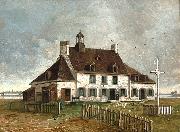 |
Henry Richard S. Bunnett
|
|
1845 -1910
David Ross McCord (1844-1930) commissioned Henry Richard S. Bunnett (1845-1910) to paint over 200 oil paintings between 1885 and 1889. The works depicted buildings, views and places around Quebec that McCord felt were of historical importance. |
|
|
|
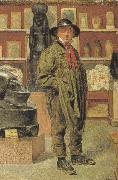 |
Henry stacy marks,R.A.
|
|
1829-1898
English painter. He studied with J. M. Leigh (1808-60) from 1847 and in January 1851 enrolled at the Royal Academy Schools. In 1852 Marks and P. H. Calderon spent five months studying in Paris under Fran?ois-Edouard Picot and at the Ecole des Beaux-Arts. The next year he made his d?but at the Royal Academy Summer Exhibition, where he exhibited annually until 1897. He was elected ARA in 1871 and RA in 1878. |
|
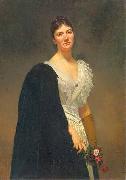 |
Henryk Rodakowski
|
|
(1823-1894) was a Polish painter.
He was befriended by the painter and activist Leon Kaplinski.
|
|
|
|
 |
Hoca Ali Riza
|
|
(1858 - 1939) was a Turkish painter.
Portrait of Hoca Ali Riza
Kizkulesi (Leander Tower), painting by Hoca Ali RizaBorn in Uskudar, Istanbul. Painted many landscapes of Istanbul and especially Uskudar. Attended Kuleli Military High School and then the Military Academy. There he studied under Osman Nuri Pasha, Seleyman Seyyid and Monsieur Gues, and graduated in 1884. From 1909 to 1912 he served as President of the Society of Ottoman Painters.
|
|
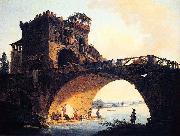 |
Hubert Robert
|
|
(22 May 1733 - 15 April 1808), French artist, was born in Paris.
His father, Nicolas Robert, was in the service of François-Joseph de Choiseul, marquis de Stainville a leading diplomat from Lorraine. Young Robert finished his studies with the Jesuits at the College de Navarre in 1751 and entered the atelier of the sculptor Michel-Ange Slodtz who taught him design and perspective but encouraged him to turn to painting. In 1754 he left for Rome in the train of Étienne-François de Choiseul, son of his father's employer, who had been named French ambassador and would become a Secretary of State for Foreign Affairs to Louis XV in 1758.
|
|
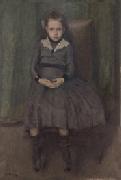 |
Hugh Ramsay
|
|
Australian portrait painter ,
1877 - 1906
was an Australian artist. Ramsay was born in Glasgow, Scotland, son of John Ramsay. He moved with his family to Melbourne in 1878. He was educated at Essendon Grammar School, and joined classes at the National Gallery of Victoria at age 16 under Lindsay Bernard Hall and became one of the most brilliant students ever trained there. He won several first prizes, and at the competition for the travelling scholarship held in 1899 was narrowly beaten by Max Meldrum, another student of unusual ability. Ramsay went to Europe in September 1900 and was fortunate in finding a kindred spirit, George Washington Lambert, on the same vessel. Arriving at Paris he entered Acad??mie Colarossi and was soon recognized as a student of great potential. He sent five pictures to the 1902 exhibition of La Soci??t?? Nationale des Beaux Arts and four of these were accepted and hung together. No greater compliment could have been paid to a young student. Another Australian student whose studio was in the same building, Ambrose McCarthy Patterson (nephew of Nellie Melba, then at the height of her fame). Ramsay was introduced to Melba, who gave him a commission for a portrait and would no doubt have been able to help him in his career. Unfortunately Ramsay became ill in Paris, and it became necessary for him to return to the warmer climate of Australia and the opportunity to paint Melba was missed. Before leaving Europe he had exhibited four pictures at the British Colonial Art Exhibition held in London at the Royal Institute galleries. Returning to Australia, in spite of failing health, Ramsay succeeded in doing some remarkable work including "The Sisters" now in the Sydney gallery, the "Lady with a Fan" (possibly his most famous painting), the portrait of David Scott Mitchell, and his own portrait now in the Melbourne gallery. He gradually became weaker and died on 5 March 1906. |
|
|
|
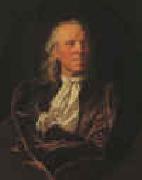 |
Hyacinthe Rigaud
|
|
1659-1743
French
Hyacinthe Rigaud Gallery
He was born Jacint Rigau i Ros [1] -- though in many encyclopaedias is "re-christened" with the name of H??acint Francesc Honrat Mathias Pere Martyr Andreu Joan Rigau -- in Perpignan, which became French (Treaty of the Pyrenees) a short time after his birth (November 7, 1659).
In 1682, he was awarded the Prix de Rome.
He was the most important portrait painter in the reign of King Louis XIV. His instinct for impressive poses and grand presentations precisely suited the tastes of the royal personages, ambassadors, clerics, courtiers, and financiers who sat for him.
Because Rigaud's paintings captured very exact likenesses along with the subject's costumes and background details, his paintings are considered precise records of contemporary fashions. Rigaud was a master of the Baroque style of art. Rigaud's best-known work is his 1701 painting of Louis XIV which today hangs in the Louvre in Paris, as well as the second copy also requested by Louis XIV which is now at Versailles.
In 1709 he was made a noble by his hometown of Perpignan. In 1727 he was made a knight of the Order of Saint Michael.
Hyacinthe Rigaud died in Paris, France on December 27, 1743. |
|
|
|
|
|
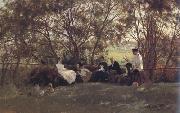 |
Ilya Repin
|
|
Ukrainian-born Russian Realist Painter, 1844-1930
was a leading Russian painter and sculptor of the Peredvizhniki artistic school. An important part of his work is dedicated to his native country, Ukraine. His realistic works often expressed great psychological depth and exposed the tensions within the existing social order. Beginning in the late 1920s, detailed works on him were published in the Soviet Union, where a Repin cult developed about a decade later, and where he was held up as a model "progressive" and "realist" to be imitated by "Socialist Realist" artists in the USSR. Repin was born in the town of Chuhuiv near Kharkiv in the heart of the historical region called Sloboda Ukraine. His parents were Russian military settlers. In 1866, after apprenticeship with a local icon painter named Bunakov and preliminary study of portrait painting, he went to Saint Petersburg and was shortly admitted to the Imperial Academy of Arts as a student. From 1873 to 1876 on the Academy's allowance, Repin sojourned in Italy and lived in Paris, where he was exposed to French Impressionist painting, which had a lasting effect upon his use of light and colour. Nevertheless, his style was to remain closer to that of the old European masters, especially Rembrandt, and he never became an impressionist himself. |
|
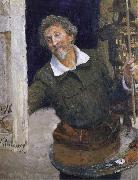 |
Ilya Yefimovich Repin
|
|
1844-1930
After training with a provincial icon painter and at the St. Petersburg Academy of Fine Arts, he visited France and Italy on an academy scholarship. On his return he began painting subjects from Russian history. In 1873 he achieved international fame with Volga Boatmen, a grim, powerful image that became the model for Soviet Socialist Realism. Among his best-known works is Ivan the Terrible and His Son Ivan (1895), depicting Ivan's murder of his son. He also painted vigorous portraits (including Leo Tolstoy and Modest Mussorgsky). In 1894 he became professor of historical painting at the St. Petersburg Academy. |
|
|
|
|
|
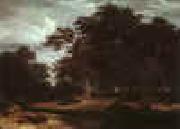 |
Jacob van Ruisdael
|
|
Dutch Baroque Era Painter, ca.1628-1682
Ruysdael's favorite subjects are simple woodland scenes, similar to those of Everdingen and Hobbema. He is especially noted as a painter of trees, and his rendering of foliage, particularly of oak leaf age, is characterized by the greatest spirit and precision. His views of distant cities, such as that of Haarlem in the possession of the marquess of Bute, and that of Katwijk in the Glasgow Corporation Galleries, clearly indicate the influence of Rembrandt.
He frequently painted coast-scenes and sea-pieces, but it is in his rendering of lonely forest glades that we find him at his best. The subjects of certain of his mountain scenes seem to be taken from Norway, and have led to the supposition that he had traveled in that country. We have, however, no record of such a journey, and the works in question are probably merely adaptations from the landscapes of Van Everdingen, whose manner he copied at one period. Only a single architectural subject from his brush is known--an admirable interior of the New Church, Amsterdam. The prevailing hue of his landscapes is a full rich green, which, however, has darkened with time, while a clear grey tone is characteristic of his seapieces. The art of Ruysdael, while it shows little of the scientific knowledge of later landscapists, is sensitive and poetic in sentiment, and direct and skillful in technique. Figures are sparingly introduced into his compositions, and such as occur are believed to be from the pencils of Adriaen van de Velde, Philip Wouwerman, and Jan Lingelbach.
Unlike the other great Dutch landscape painters, Ruysdael did not aim at a pictorial record of particular scenes, but he carefully thought out and arranged his compositions, introducing into them an infinite variety of subtle contrasts in the formation of the clouds, the plants and tree forms, and the play of light. He particularly excelled in the painting of cloudscapes which are spanned dome-like over the landscape, and determine the light and shade of the objects.
Goethe lauded him as a poet among painters, and his work shows some of the sensibilities the Romantics would later celebrate. |
|
 |
Jacopo Robusti Tintoretto
|
|
1518-1594
Italian Tintoretto Galleries
The real name of Tintoretto was Jacopo Robusti, but he is better known by his nickname, meaning the "little dyer, " his father having been a silk dyer. The artist was born in Venice and lived there all his life. Even though his painting is distinguished by great daring, he seems to have led a rather retired life, concerned only with his work and the well-being of his family. His daughter Marietta and his sons Domenico and Marco also became painters, and Domenico eventually took over the direction of Tintoretto's large workshop, turning out reliable but un-inspired pictures in the manner of his father. Some of them are, on occasion, mistaken for works of the elder Tintoretto.
Tintoretto appears to have studied with Bonifazio Veronese or Paris Bordone, but his true master, as of all the great Venetian painters in his succession, was Titian. Tintoretto's work by no means merely reflects the manner of Titian. Instead he builds on Titian's art and brings into play an imagination so fiery and quick that he creates an effect of restlessness which is quite opposed to the staid and majestic certainty of Titian's statements. If Tintoretto's pictures at first sight often astonish by their melodrama, they almost inevitably reveal, at closer observation, a focal point celebrating the wonders of silence and peace. The sensation of this ultimate gentleness, after the first riotous impact, is particularly touching and in essence not different from what we find (although brought about by very different means) in the pictures of Titian and Paolo Veronese.
Tintoretto was primarily a figure painter and delighted in showing his figures in daring foreshortening and expansive poses. His master in this aspect of his art was Michelangelo. Tintoretto is supposed to have inscribed on the wall of his studio the motto: "The drawing of Michelangelo and the color of Titian." Unlike Michelangelo, however, Tintoretto worked and drew very quickly, using only lights and shadows in the modeling of his forms, so that his figures look as if they had gained their plasticity by a kind of magic. In the rendering of large compositions he is reported to have used as models small figures which he made of wax and placed or hung in boxes so cleverly illuminated that the conditions of light and shade in the picture he was painting would be the same as those in the room in which it was to be hung. |
|
|
|
|
|
James clarke hook,r.a
|
|
1819-1907
English painter. He studied with the portrait painter John Jackson and entered the Royal Academy Schools, London, in 1836, winning medals for drawing and historical painting. His Academy d?but was in 1839 with The Hard Task (untraced). In 1844 Hook was awarded a gold medal in the Houses of Parliament competition. In 1846 he won a Royal Academy travelling scholarship, enabling him to spend two years in Italy, where he was strongly influenced by the colouring of the Venetian painters. On his return his work included a series of subjects from Venetian history, including The Rescue of the Brides of Venice |
|
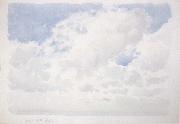 |
James Walter Robert Linton
|
|
water-colourist ,English. 1869-1947
Australian silversmith, jeweller, woodworker and painter of English birth. His father was the watercolourist Sir James Dromgole Linton (1840-1916). Having trained as a painter and architect in London, he travelled to Western Australia in 1896 and began practising metalwork after settling in Perth; he was appointed head of the art department of Perth Technical School in 1902. Following a trip to London in 1907, when he attended classes at the Sir John Cass Technical Institute under Harold Stabler, he concentrated on producing metalwork. Working in partnership with Arthur Cross, William Andrews and his own son Jamie Linton (1904-80), he produced ecclesiastical and domestic wares, presentation pieces and jewellery. His designs were influenced by British Arts and Crafts metalwork and were bold and simple, with decoration generally confined to hammered surfaces, twisted wire, hardstones and enamels. |
|
 |
Jan Antonisz. van Ravesteyn
|
|
(1572(?) - buried June 21, 1657) was a successful painter to the Dutch court in The Hague.
Van Ravensteyn was born in The Hague. It is unknown who taught him how to paint, but he was a follower of the Delft portrait painter Michiel Jansz van Mierevelt. Van Ravesteyn is mentioned there in the city archives 1597. From 1598 until his death he lived in the Hague, where in 1598 he became a member of the Guild of St. Luke of the Hague. In 1604 he married Anna Arentsz van Berendrecht and in the same year he was mentioned as a good painter by Karel van Mander (though his earliest dated works are from 1611). In 1608 he bought a house on the Molstraat and in 1628 he moved in the Molstraat. In 1640 his wife was buried and in the same year his daughter Marie married one of his pupils, the painter Adriaen Hanneman. In 1654 he moved to the Nobelstraat next to the house of his daughter. In 1656 he left the guild with a group of dissatified painter friends and was one of the founders of the Confrerie Pictura. He was a Catholic and his name occurs often as a witness in the records of the church in the Molstraat, such as for the marriage of his daughter Agnes in 1641 with Willem van Culemborgh. His portrait was painted by Sir Anthony van Dyck and he produced Schutterstuk works. His workshop produced many portraits for the royal house of Nassau and he competed with Miereveld for several commissions.
Van Ravesteyn was in turn, the teacher of Dirck Abrahamsz., Leendert Barthouts, Johannes Harmensz. Borsman, Aelbert Dircksz. Coeppier, Pieter Craen, Jacob Dirksz. van den Enden, Fransise de Goltz, Adriaen Hanneman, Barent Jansz., Thomas Ouwater, Clement Ram, Jan Rassenbourch, Frederick Sonnius, Dirck Verlaer, Jan Pous Voet and Pauwels Willemsz.
|
|
|

